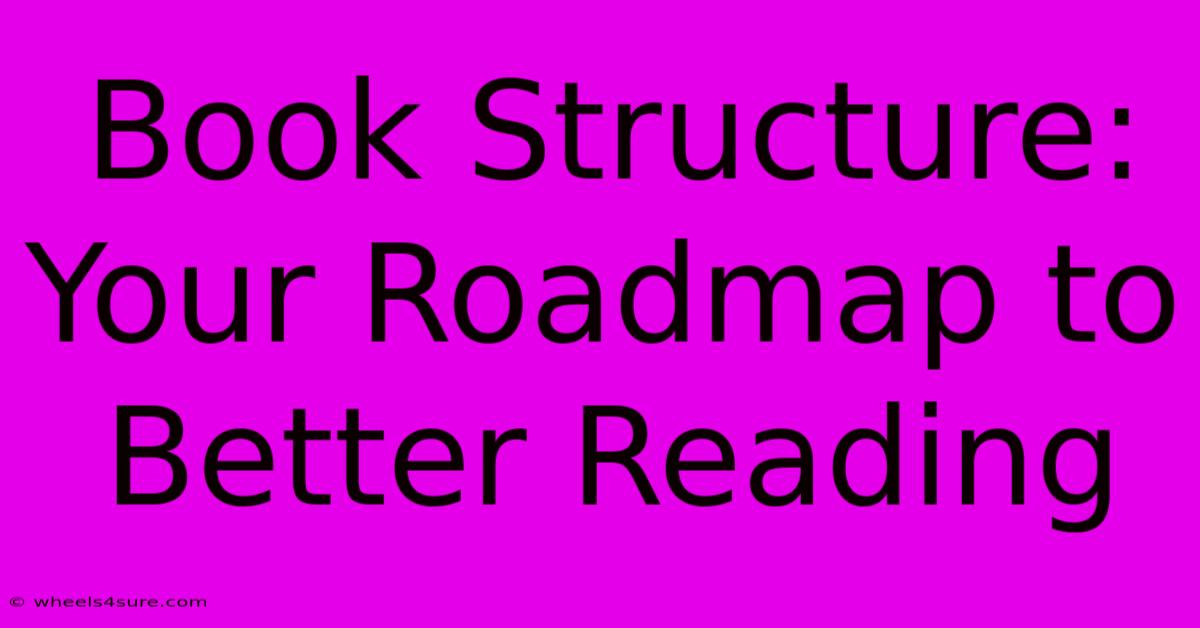Book Structure: Your Roadmap To Better Reading

Table of Contents
Book Structure: Your Roadmap to Better Reading
Understanding a book's structure isn't just about passively turning pages; it's about actively engaging with the text and maximizing your comprehension and enjoyment. Knowing how authors craft their narratives allows you to anticipate plot twists, understand character motivations, and ultimately, gain a deeper appreciation for the story. This guide will illuminate the common structural elements found in books and how understanding them can enhance your reading experience.
Decoding the Narrative Arc: The Foundation of Book Structure
Most books, particularly novels, follow a basic narrative arc. This arc isn't a rigid formula, but rather a flexible framework that guides the reader through the story. Understanding its components helps you navigate the narrative flow:
1. Exposition: Setting the Stage
The exposition introduces the setting, characters, and initial conflict. Think of it as the foundational layer upon which the rest of the story is built. Authors carefully craft this section to establish the world and draw the reader into the narrative. Paying close attention to the exposition allows you to grasp the fundamental elements early on.
2. Rising Action: Building the Tension
This is where the conflict intensifies. Subplots emerge, challenges mount, and the stakes rise. The rising action is characterized by a series of events that build suspense and lead the protagonist toward a climactic confrontation. Recognizing this stage helps you anticipate the turning points and major events to come.
3. Climax: The Peak of the Story
The climax represents the turning point of the story. It's the point of highest tension and often involves a crucial confrontation or decision. The climax marks the peak of the conflict, after which the narrative begins to resolve itself. Understanding the climax helps you appreciate the narrative's overall trajectory.
4. Falling Action: Untangling the Threads
Following the climax, the falling action gradually resolves the conflict. Loose ends are tied up, and the consequences of the climax are revealed. This section provides a sense of closure and allows the reader to process the events that have transpired. Paying attention to the falling action ensures you don't miss vital details that shape the story's overall meaning.
5. Resolution/Denouement: The Aftermath
This is the final stage where the story concludes. The resolution reveals the ultimate outcome of the conflict and provides a sense of closure. The denouement often explores the lingering effects of the events and offers a final reflection on the characters and their journey. Understanding the resolution provides a complete understanding of the story's message.
Beyond the Narrative Arc: Other Structural Elements
While the narrative arc is fundamental, other structural elements influence the overall reading experience:
- Chapter Structure: Authors use chapters to break up the narrative, create pacing, and introduce thematic shifts. Paying attention to chapter breaks can help you understand the flow and pacing of the story.
- Point of View: The perspective from which the story is told (first-person, third-person limited, third-person omniscient) significantly impacts the reader's experience. Understanding the point of view helps you interpret the narrative and character motivations.
- Flashback/Flashforward: These techniques disrupt the chronological order to provide context or foreshadow future events. Recognizing them allows you to understand the narrative's complexities.
- Foreshadowing and Suspense: Authors utilize these literary devices to create anticipation and engagement. Being aware of them heightens your reading experience.
Improving Your Reading Through Structural Awareness
By understanding the different structural elements, you can:
- Predict plot developments: Anticipate upcoming events based on your understanding of the narrative arc.
- Analyze character motivations: Gain insight into characters' actions by understanding their place within the story's structure.
- Appreciate thematic elements: Recognize recurring themes and motifs by observing their placement within the story's structure.
- Enhance comprehension: Navigate the narrative flow more effectively, leading to improved understanding.
In conclusion, actively engaging with a book's structure transforms passive reading into an active, enriching experience. By understanding the narrative arc and other structural elements, you gain a deeper appreciation for the author's craft and unlock a more profound understanding of the story itself. So, next time you pick up a book, remember to consider its structure – it’s your roadmap to better reading.

Thank you for visiting our website wich cover about Book Structure: Your Roadmap To Better Reading. We hope the information provided has been useful to you. Feel free to contact us if you have any questions or need further assistance. See you next time and dont miss to bookmark.
Featured Posts
-
The Secrets Behind Bhad Bhabies Net Worth
Apr 12, 2025
-
Xqc Net Worth The Future Is Bright
Apr 12, 2025
-
Book Structure Your Roadmap To Better Reading
Apr 12, 2025
-
Sophie Rains Only Fans Net Worth And Business Model
Apr 12, 2025
-
Antigens Understanding Your Bodys Defense Mechanisms
Apr 12, 2025
